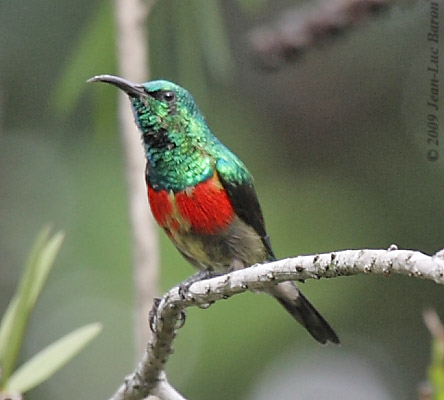m |
(→External Links: GSearch Checked template) |
||
| (9 intermediate revisions by 4 users not shown) | |||
| Line 1: | Line 1: | ||
| − | ;Cinnyris chloropygius | + | ;[[:Category:Cinnyris|Cinnyris]] chloropygius |
''Nectarinia chloropygia'' | ''Nectarinia chloropygia'' | ||
| + | |||
| + | [[Image:Olive-bellied_Sunbird.jpg|thumb|550px|right|Photo by {{user|Jeluba|Jeluba}} <br />Brazzaville, [[Republic of the Congo]], November 2009]] | ||
==Identification== | ==Identification== | ||
| − | + | 10.5–11.0 cm. Glossy dark green forehead to back and throat; scarlet breast, brown wings and tail, and olive belly. | |
==Distribution== | ==Distribution== | ||
| − | + | Southeastern [[Nigeria]] to [[Angola]]. | |
| + | |||
==Taxonomy== | ==Taxonomy== | ||
| + | This is one of the many Sunbirds that have recently been moved to the genus ''Cinnyris'' from the genus ''Nectarinia''. | ||
| + | |||
==Habitat== | ==Habitat== | ||
| − | + | Forests, plantations, mangroves, farmland, well-wooded savanna, parks, and gardens. | |
==Behaviour== | ==Behaviour== | ||
| − | + | Diet includes the flowers of hibiscus, bougainvillea, and other garden flowers, but also attracted to banana, cassava, and coffee flowers. It also takes small insects, spiders, and seeds. | |
| − | |||
| − | |||
| + | It builds an oval nest made from grass, dead leaves, and bark, suspended from bush or palm. 1-3 white or grey eggs are laid. It is parasitized by the [[African Emerald Cuckoo]] and by [[Cassin's Honeyguide]]. | ||
==External Links== | ==External Links== | ||
| − | {{GSearch| | + | {{GSearch|Sunbird+chloropyg*}} |
| − | {{ | + | {{GS-checked}} |
| − | [[Category:Birds]] [[Category: | + | <br /> |
| + | <br /> | ||
| + | |||
| + | [[Category:Birds]] [[Category:Cinnyris]] | ||
Latest revision as of 14:52, 2 January 2022
- Cinnyris chloropygius
Nectarinia chloropygia
Identification
10.5–11.0 cm. Glossy dark green forehead to back and throat; scarlet breast, brown wings and tail, and olive belly.
Distribution
Southeastern Nigeria to Angola.
Taxonomy
This is one of the many Sunbirds that have recently been moved to the genus Cinnyris from the genus Nectarinia.
Habitat
Forests, plantations, mangroves, farmland, well-wooded savanna, parks, and gardens.
Behaviour
Diet includes the flowers of hibiscus, bougainvillea, and other garden flowers, but also attracted to banana, cassava, and coffee flowers. It also takes small insects, spiders, and seeds.
It builds an oval nest made from grass, dead leaves, and bark, suspended from bush or palm. 1-3 white or grey eggs are laid. It is parasitized by the African Emerald Cuckoo and by Cassin's Honeyguide.
External Links
GSearch checked for 2020 platform.




